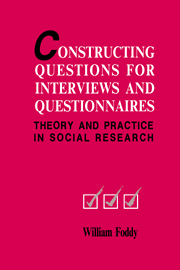Book contents
- Frontmatter
- Contents
- Tables
- Figures
- Preface
- Chapter 1 An initial statement of the problem
- Chapter 2 A theoretical framework
- Chapter 3 Defining topics properly
- Chapter 4 Formulating intelligible requests for information
- Chapter 5 Contextual influences on respondents' interpretations of questions
- Chapter 6 The need to provide response frameworks
- Chapter 7 The limitations of human memory
- Chapter 8 Filters: establishing the relevance of questions to respondents
- Chapter 9 Reducing question threat
- Chapter 10 The open vs. closed questions debate
- Chapter 11 Measuring attitudes
- Chapter 12 Checks to ensure that questions work as intended
- Chapter 13 Concluding comments
- The tap paradigm
- References
- Index
- Acknowledgements
Chapter 12 - Checks to ensure that questions work as intended
Published online by Cambridge University Press: 04 September 2009
- Frontmatter
- Contents
- Tables
- Figures
- Preface
- Chapter 1 An initial statement of the problem
- Chapter 2 A theoretical framework
- Chapter 3 Defining topics properly
- Chapter 4 Formulating intelligible requests for information
- Chapter 5 Contextual influences on respondents' interpretations of questions
- Chapter 6 The need to provide response frameworks
- Chapter 7 The limitations of human memory
- Chapter 8 Filters: establishing the relevance of questions to respondents
- Chapter 9 Reducing question threat
- Chapter 10 The open vs. closed questions debate
- Chapter 11 Measuring attitudes
- Chapter 12 Checks to ensure that questions work as intended
- Chapter 13 Concluding comments
- The tap paradigm
- References
- Index
- Acknowledgements
Summary
Numerous examples of questions which have not worked as they were intended to work have been presented throughout the previous chapters. Reference has also been made to a number of studies in which questions that had supposedly been piloted in order to iron out any faults were misunderstood by large percentages of respondents. We will take another look at these studies, now, because they set the stage for the rest of this chapter.
Nuckols (1953) took nine questions from ‘The Quarters Polls’ that varied in difficulty and presented them to forty-eight randomly chosen, middle-income respondents. The respondents were asked to restate the questions ‘in their own words’. One in six of the interpretations given was either partly or completely wrong. An unexpected finding was that there was little, if any, relationship between the error rate and the difficulty ratings for the questions.
Belson (1981) advances similar findings. He and his colleagues analysed over 2000 questions that had been designed by twenty-four different market researchers over a two-year period and identified questions that might be expected to cause respondents some difficulty. They then selected for in-depth study four examples of each of the six most frequently occurring kinds of problem questions. The kinds of questions selected for investigation were questions that required more than one answer; contained too many meaningful words; included qualifying clauses or phrases; included reference to two or more subjects; included difficult vocabulary; or included instructions.
- Type
- Chapter
- Information
- Constructing Questions for Interviews and QuestionnairesTheory and Practice in Social Research, pp. 181 - 188Publisher: Cambridge University PressPrint publication year: 1993



